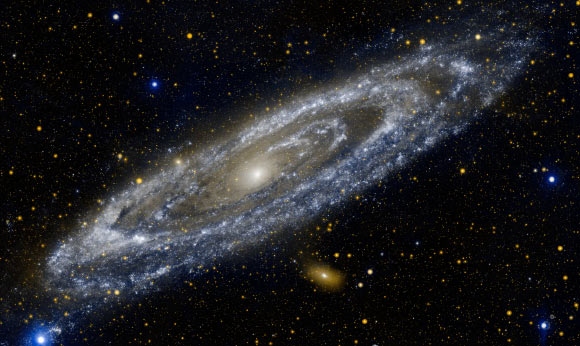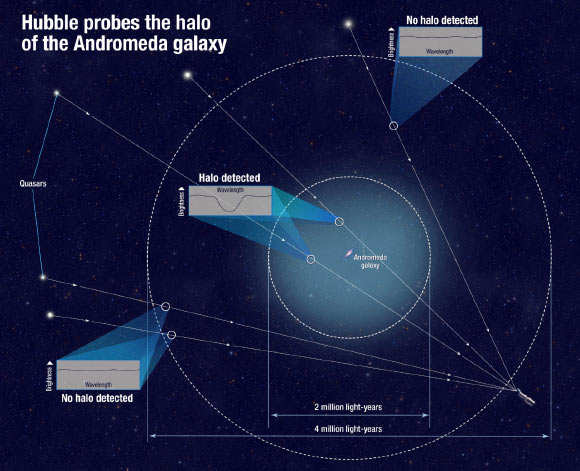Astronomers using the Cosmic Origins Spectrograph (COS) on the NASA/ESA Hubble Space Telescope have discovered that a nearly invisible halo of hot plasma surrounding the Andromeda Galaxy is 6 times larger and 1,000 times more massive than previously measured.

Hot stars burn brightly in this image from NASA’s Galaxy Evolution Explorer, showing the UV side of a familiar face. At 2.5 million light-years away, the Andromeda galaxy is our Milky Way’s largest galactic neighbor. The bands of blue-white making up the galaxy’s striking rings are neighborhoods that harbor hot, young, massive stars. Dark blue-grey lanes of cooler dust show up starkly against these bright rings, tracing the regions where star formation is currently taking place in dense cloudy cocoons. Eventually, these dusty lanes will be blown away by strong stellar winds, as the forming stars ignite nuclear fusion in their cores. Meanwhile, the central orange-white ball reveals a congregation of cooler, old stars that formed long ago. When observed in visible light, the galaxy’s rings look more like spiral arms. Image credit: NASA / JPL-Caltech.
The Andromeda Galaxy, also known as NGC 224, Messier 31 or M31, is a spiral galaxy approximately 2.5 million light-years away.
It contains over 100 billion stars and is comparable in size to our Milky Way Galaxy. It can be seen as a cigar-shaped smudge of light high in the autumn sky. But if you could see the huge bubble of hot, diffuse plasma surrounding the galaxy, it would appear 100 times the angular diameter of the full Moon.
The dark, nearly invisible halo stretches about a million light-years from its host galaxy, halfway to our home galaxy, and is estimated to contain half the mass of the stars in the galaxy itself. It can be thought of as the ‘atmosphere’ of a galaxy.
“Halos are the atmospheres of galaxies. The properties of these gaseous halos control the rate at which stars form in galaxies according to models of galaxy formation,” said Dr Nicolas Lehner of the University of Notre Dame, Indiana, who is the lead author on the study published in the Astrophysical Journal (arXiv.org version).
Dr Lehner and his colleagues, Dr Bart Wakker of the University of Wisconsin-Madison and Dr Christopher Howk of the University of Notre Dame, used 18 quasars residing far behind Andromeda to probe how material is distributed well beyond the visible disk of the galaxy.
They observed the quasars’ light as it traveled through the intervening gas. The halo’s plasma absorbed some of that light and made the quasar appear darker in a very small wavelength range.
By measuring the tiny dip in brightness at that specific range, they could tell how much gas is between us and each quasar. Some quasars showed no dip in brightness, and this helped define the size of the halo.

This diagram shows how scientists determined the size of the halo of the Andromeda Galaxy. Because the gas in the halo is dark, astronomers measured it by using the light from distant quasars. Image credit: NASA / ESA / A. Field, STScI / N. Lehner & J.C. Howk, University of Notre Dame / B. Wakker, University of Wisconsin, Madison.
“This is a new milestone because typically only one quasar is used to probe the halos of galaxies beyond the Local Group. Here we have assembled a large sample of quasars that directly demonstrate the true extent of the halo of a single massive galaxy,” Dr Lehner said.
Previous research studied 44 distant galaxies and found halos like Andromeda’s, but never before has such a massive halo been seen in a neighboring galaxy. Because the galaxies were much farther away, they appeared much smaller on the sky. Only one quasar could be detected behind each faraway galaxy, providing only one light anchor point to map their halo size and structure. With its close proximity to Earth and its correspondingly large footprint on the sky, Andromeda provides a far more extensive sampling of a lot of background quasars.
According to the astronomers, over Andromeda’s lifetime, nearly half of all the heavy elements made by its stars have been expelled far beyond the galaxy’s 200,000 light-year-diameter stellar disk.
They predict that if our own Galaxy possesses a similar halo to Andromeda, the two galaxies’ halos may merge well before the two massive galaxies collide and eventually form a giant elliptical galaxy beginning about 4 billion years from now.
_____
Nicolas Lehner et al. 2015. Evidence for a Massive, Extended Circumgalactic Medium Around the Andromeda Galaxy. ApJ 804, 79; doi: 10.1088/0004-637X/804/2/79







